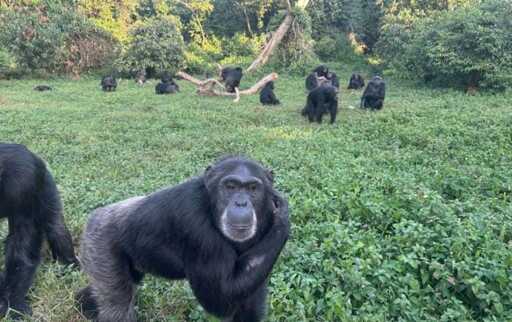🌘Subscribe to 404 Media to get The Abstract, our newsletter about the most exciting and mind-boggling science news and studies of the week. 
Chimpanzees revise their beliefs if they encounter new information, a hallmark of rationality that was once assumed to be unique to humans, according to a study published on Thursday in Science.
Researchers working with chimpanzees at the Ngamba Island Chimpanzee Sanctuary in Uganda probed how the primates judged evidence using treats inside boxes, such as a “weak” clue—for example, the sound of a treat inside a shaken box—and a “strong” clue, such as a direct line of sight to the treat.
The chimpanzees were able to rationally evaluate forms of evidence and to change their existing beliefs if presented with more compelling clues. The results reveal that non-human animals can exhibit key aspects of rationality, some of which had never been directly tested before, which shed new light on the evolution of rational thought and critical thinking in humans and other intelligent animals.
“Rationality has been linked to this ability to think about evidence and revise your beliefs in light of evidence,” said co-author Jan Engelmann, associate professor at the department of psychology at the University of California, Berkeley, in a call with 404 Media. “That’s the real big picture perspective of this study.”
While it’s impossible to directly experience the perspective of a chimpanzee, Engelmann and his colleagues designed five controlled experiments for groups of anywhere from 15 to 23 chimpanzee participants.
In the first and second experiments, the chimps received a weak clue and a strong clue for a food reward in a box. The chimpanzees consistently made their choices based on the stronger evidence, regardless of the sequence in which the clues were presented. In the third experiment, the chimps were shown an empty box in addition to the strong and weak clues. After this presentation, the box with the strong evidence was removed. In this experiment, the chimpanzees still largely chose the weak clue over the empty box.
In the fourth experiment, chimpanzees were given a second “redundant” weak clue—for instance, the experimenter would shake a box twice. Then, they were given a new type of clue, like a second piece of food being dropped into a box in front of them. They were significantly more likely to change their beliefs if the clue provided fresh information, demonstrating an ability to distinguish between redundant and genuinely new evidence.
Finally, in the fifth experiment, the chimpanzees were presented with a so-called “defeater” that undermined the strong clue, such as a direct line of sight to a picture of food inside the box, or a shaken box containing a stone, not a real treat. The chimps were significantly more likely to revise their choice about the location of the food in the defeater experiments than in experiments with no defeater. This experiment showcased an ability to judge that evidence that initially seems strong can be weakened with new information.
“The most surprising result was, for sure, experiment five,” Engelmann said. “No one really believed that they would do it, for many different reasons.”
For one thing, he said, the methodology of the fifth experiment demanded a lot of attention and cognitive work from the chimpanzees, which they successfully performed. The result also challenges the assumption that complex language is required to update beliefs with new information. Despite lacking this linguistic ability, chimpanzees are somehow able to flexibly assign strength to different pieces of evidence.
Speaking from the perspective of the chimps, Engelmann outlined the responses to experiment five as: “I used to believe food was in there because I heard it in there, but now you showed me that there was a stone in there, so this defeats my evidence. Now I have to give up that belief.”
“Even using language, it takes me ten seconds to explain it,” he continued. “The question is, how do they do it? It’s one of the trickiest questions, but also one of the most interesting ones. To put it succinctly, how to think without words?”
To hone in on that mystery, Engelmann and his colleagues are currently repeating the experiment with different primates, including capuchins, baboons, rhesus macaques, and human toddlers and children. Eventually, similar experiments could be applied to other intelligent species, such as corvids or octopuses, which may yield new insights about the abundance and variability of rationality in non-human species.
“I think the really interesting ramification for human rationality is that so many people often think that only humans can reflect on evidence,” Engelmann said. “But our results obviously show that this is not necessarily the case. So the question is, what’s special about human rationality then?”
Engelmann and his colleagues hypothesize that humans differ in the social dimensions of our rational thought; we are able to collectively evaluate evidence not only with our contemporaries, but by consulting the work of thinkers who may have lived thousands of years ago. Of course, humans also often refuse to update beliefs in light of new evidence, which is known as “belief entrenchment” or “belief perseveration” (many such cases). These complicated nuances add to the challenge of unraveling the evolutionary underpinnings of rationality.
That said, one thing is clear: many non-human animals exist somewhere on the gradient of rational thought. In light of the recent passing of Jane Goodall, the famed primatologist who popularized the incredible capacities of chimpanzees, the new study carries on a tradition of showing that these primates, our closest living relatives, share some degree of our ability to think and act in rational ways.
Goodall “was the first Western scientist to observe tool use in chimpanzees and really change our beliefs about what makes humans unique,” Engelmann said. “We’re definitely adding to this puzzle by showing that rationality, which has so long been considered unique to humans, is at least in some forms present in non-human animals.”
🌘Subscribe to 404 Media to get The Abstract, our newsletter about the most exciting and mind-boggling science news and studies of the week.
From 404 Media via this RSS feed
Pasting the experiment design summary here just because I’m always impressed by the ways animal/baby experiments are designed to get at the research question:
Schleihauf et al. gave subjects eight opportunities to locate food hidden in two identical containers. Chimpanzees could select one of the containers but not both. For each trial, they received two sequential clues: one providing strong, conclusive evidence, and the other offering weak, inconclusive evidence. In half of the trials, the strong clue was presented first, followed by the weak; in the other half, the order was reversed. Chimpanzees consistently based their choices on the strong form of evidence, regardless of the order or modality (visual, when food could be seen inside the container, or auditory, when the container made a noise indicative of food when shaken) in which they received the information. Notably, when weak evidence was encountered first, subjects frequently revised their choice after being exposed to the stronger evidence, which is consistent with rational revision of beliefs.
To determine whether chimpanzees were simply discarding weaker evidence in favor of stronger evidence, three containers were used: One container provided auditory evidence, another provided visual evidence, and the third provided no evidence. Critically, the container with the strongest visual evidence of food was removed after presentation. If subjects had simply discarded weaker evidence once encountering stronger evidence, then their choices of a container should have been random. Instead, chimpanzees chose the container with weaker auditory evidence, suggesting that they integrated the relative strength of all evidence rather than overwriting weaker clues.
The study also revealed that chimpanzees are sensitive not only to the type but also to the quantity of evidence available to support their choices. Subjects were first exposed to weak evidence (a sound resembling food being dropped) and then stronger evidence (a treat visible in another container). As expected, subjects initially chose the container with the visible treat. However, when provided with additional auditory evidence suggesting that two treats might be hidden together, they revised their decision and switched away from the container where they had seen only one treat. This change occurred more often than in a control condition in which subjects only received auditory evidence that reaffirmed that the food they initially heard was still present in the container.
What about the effect of misleading evidence? Subjects were shown food in a container through a transparent cover only to discover that what they had initially seen was not a treat but a picture of a treat painted on the cover. Chimpanzees switched away from the misleading evidence more often than in a control condition in which the transparent cover was unmarked.
In the experiments by Schleihauf et al., chimpanzees consistently made rational choices two or three times more often than nonrational ones in all scenarios. These findings demonstrate that nonhuman apes have a spontaneous ability to weigh evidence of varying strengths, revise prior choices, and adapt when evidence is revealed to be unreliable.


